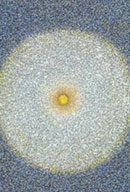Creations

Rosh Hashanah, the beginning of the year, marks the creation of the world. Or does it? The Torah refers to Rosh Hashanah, although not by that name, as the first day of "the seventh month" (Leviticus 23:24)—the seventh, that is, if you're counting from Nisan, the month of Passover. That month is designated as the beginning of the year in the first act of the Exodus: "This month will mark for you the first of the months; it will be, for you, the first month of the year" (Exodus 12:2). Like revolutionaries everywhere, the Israelites wanted a new calendar.
Nisan is in springtime, when new life springs from below. Fittingly, it also marks the birth of Israel through the redemption from Egypt: the starting point of a particular nation's history. By contrast, the seventh month, Tishrei, falls at the outset of the rainy season in the land of Israel , when the brown fields of summer are watered from above.
The Talmud (in Tractate Rosh Hashanah) lists no fewer than four new years, depending on what's being counted: the first of Nisan for the reign of kings and the annual cycle of pilgrimages to Jerusalem; the first of Ellul for animal tithes; the 15th (some say, the first) of Sh'vat for tithing trees; and, finally, the first of Tishrei for figuring sabbatical and jubilee years, the planting years of vegetables and saplings, and, somewhat cryptically, "counting years."
Counting for what purpose? On this, the Talmud registers three opinions: for recording dates in contracts and the like; for marking seasons, in particular the autumnal equinox when day is perfectly balanced with night; and, finally, "for judgment." The last view echoes the declaration of the Mishnah that "on Rosh Hashanah all the world's inhabitants pass before Him in formation, as the Psalmist says: 'He who fashions the hearts of them all, who discerns all their doings' (Psalms 33:15)."
And what about when the world was created? Again, an argument: some say Nisan, others Tishrei. In his comment on this talmudic passage, Jacob Tam, the magisterial rabbinical authority of 12th-century France, concludes that "both [views] are the words of the living God." Tishrei, he asserts, was when the thought of creation arose in God's mind; Nisan was when the actual work of creation began.
In other words: Tishrei marks the universal event, correlative to the rainy heavens that encompass the whole world. Nisan marks the particular event, creation on the ground, correlative to the birth of the nation of Israel. The universal and the particular are different aspects of creation, and both are essential to its flourishing. The specifics of place, language, and kin make us recognizable to ourselves, real buds in real gardens; the sense of humanity writ large takes us beyond ourselves, rescuing us from self-centered autism and tying us to everyone who has ever lived, all children of the universal God.
The rabbis' linking of creation with judgment, and both creation and judgment with the equinox, suggests other mutually reinforcing emphases. The world arises from, one might say, the equinox of judgment, the divine balance between justice and mercy. On another level, the creation/judgment connection drives home the truth of the Mishnaic dictum that every human being both constitutes a whole world and plays a role in shaping the world around him. Between the individual and the human whole, or indeed the cosmic whole, stands the middle term, the Jewish collective, which historically comes into existence in Nisan.
The gap between the universal and the particular, like the gap between the ideal and the real, is woven into the fabric of experience. Jewish life tries to fill that gap, in the recognition that even the most universal values must be concretely embodied—or be nothing at all. How well are we doing in bridging the gap? On that we will be judged.
Comments are closed for this article.





And there are 2 equinoxes per year... Spring and Autumn!!